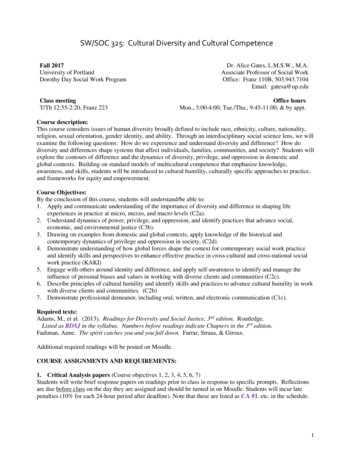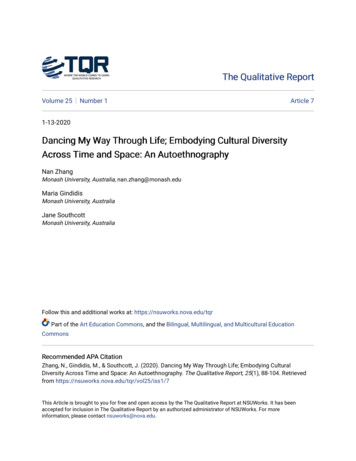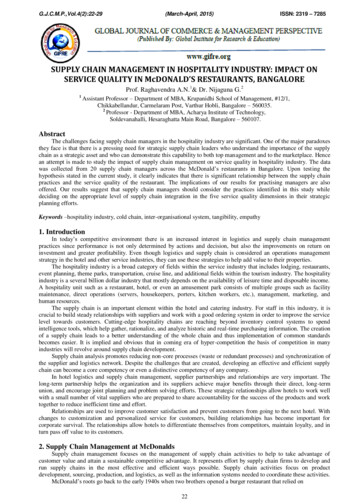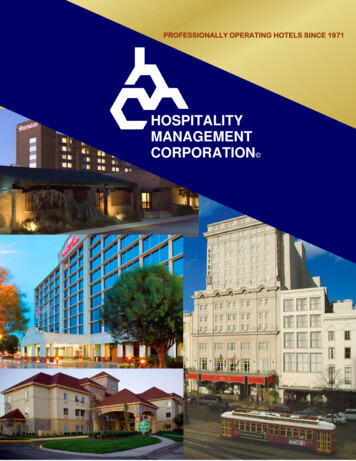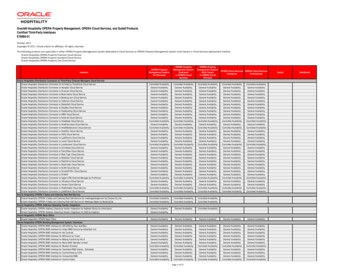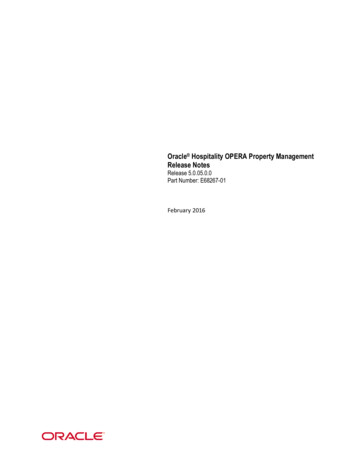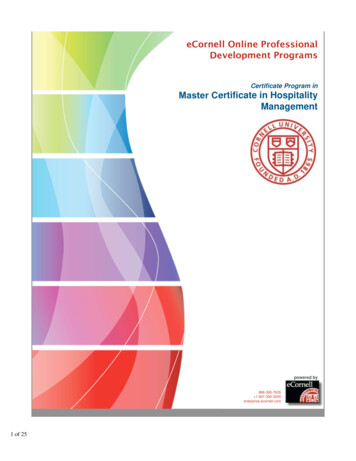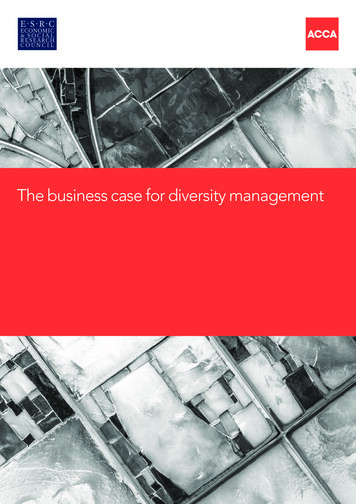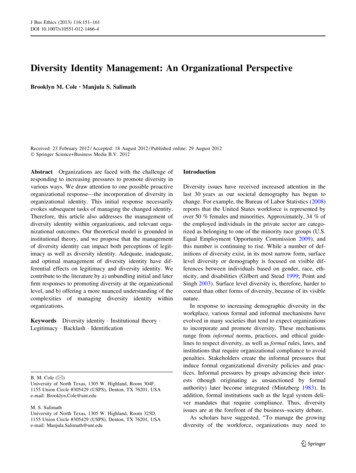
Transcription
Bachelor's thesisDegree Programme In Hospitality ManagementHospitality Management2012Veera KorjalaCULTURAL DIVERSITY INHOSPITALITY MANAGEMENT– How to improve cultural diversity workforce
BACHELOR'S THESIS ABSTRACTTURKU UNIVERSITY OF APPLIED SCIENCESDegree Programme In Hospitality Management Hospitality Management2012 64Susanna SaariVeera KorjalaCULTURAL DIVERSITY IN HOSPITALITYMANAGEMENTThe bachelor s thesis investigates cultural diversity in the hospitality management. It aims atpresenting effective ways to improve cultural diversity in a workplace. This study wascommissioned by JW Marriott San Antonio Hill Country Resort & Spa in Texas, USA and threehotels in Stillwater, Oklahoma, USA: Atherton Hotel, Hampton Inn & Suites and Residence Inn.The bachelor s thesis incorporates culture theories and their applications to the workplace.Additionally, it focuses on cultural diversity dimensions in hospitality workplace, such as itsbenefits and challenges, its reflection in the work environment which have been related to theorganization’s cultural diversity management. Eventually it provides solutions, such as acorporate strategic plan which focuses on the improvement of cultural diversity in the workplaceby means of cultural diversity training. These best practices of cultural diversity are discussed indetail both in the literature review and in the study.The bachelor’s thesis has used two research methods, both qualitative and quantitativeresearch approach. Qualitative research method was implemented by seven in-depth interviewswith a target group of managers in the JW Marriott resort hotel whereas the quantitativeresearch component executed captive questionnaire survey and included target group of entireworkforce of the three properties in Stillwater. The aim of the interview was to support theliterature review and gather new ideas and improvement areas for cultural diversitymanagement and culture infusion. The captive questionnaire survey mainly focused oncollecting employees’ attitudes towards their cultural values and other employees’ cultures.Cultural diversity can have a significant influence on the hospitality business. The study revealsthat cultural diversity is highly important in hospitality business due to global customer-relatedindustry. However, this phenomenal benefit has challenges as well, such as communicationbarriers between employees. The best practices for enhancing cultural diversity resulted inestablishing a cultural diversity committee, a language bank or a cultural event. Additionally,customs are the most appealing cultural attribute which the workforce wants to discover fromother cultures. Cultural diversity has been considered in the hospitality business but is notcarefully implemented. Therefore, there is a strong need for more education and training oncultural diversity in the future.KEYWORDS:Culture, diversity, cultural diversity, management, cultural diversity training, cultural diversitymanagement, lodging business, hotels, tourism.
OPINNÄYTETYÖ (AMK) TIIVISTELMÄTURUN AMMATTIKORKEAKOULUPalvelujen tuottamisen ja johtamisen koulutusohjelma Restonomi2012 64Susanna SaariVeera KorjalaMONIKULTTUURISUUDEN JOHTAMINENMATKAILUALALLATämä opinnäytetyö käsittelee monikulttuurista työympäristöä matkailualalla. Sen keskeinentavoite on selvittää tehokkaita monikulttuurisuuden parantamiskeinoja työympäristössä.Toimeksiantajina ovat olleet sekä monikansallinen matkailuyritys JW Marriott San Antonio HillCountry Resort & Spa, Texas, Yhdysvallat että kolme hotellia Stillwaterista, Oklahomasta,Yhdysvalloista: Atherton Hotel, Hampton Inn & Suites ja Residence Inn.Opinnäytetyö pohjautuu kulttuuriteorioihin ja kulttuurien monimuotoisuuteen, ja niidenvaikutuksiin matkailualan työympäristössä, joita johdetaan monikulttuurisesti. Lisäksi työssänitarkastellaan monikulttuurisuuden hyötyjä ja haasteita. Näiden lisäksi työ tutustuttaa ratkaisujanäihin haasteisiin; erityisesti strategisen suunnitelman, joka perehtyy monikulttuurisuudenkehittämiseen yrityksessä monikulttuurisuuden harjoittelun avulla. Näitä ratkaisuehdotuksiakäsitellään sekä teoria- että tutkimusosiossa.Tässä opinnäytetyössä on käytetty sekä laadullista että määrällistä tutkimusmenetelmää. Laadullinen tutkimus toteutettiin haastattelemalla seitsemää resort-hotellin johtajaa JW Marriottissa.Määrällinen tutkimusosa toteutettiin puolestaan kyselyllä. Kyselyssä kohderyhmänä olivat edellämainittujen Stillwaterin hotellien työntekijät. Haastattelujen tavoitteena oli tukea teoriaosiossakäsiteltyjä aiheita sekä saada uusia ideoita ja kehitysehdotuksia monikulttuurisuuden johtamiseen ja kulttuurien integrointiin. Kyselyjen tavoitteena oli pääasiassa selvittää, millaisia asenteita työntekijöillä on omiin kulttuuriarvoja ja muiden työntekijöiden kulttuureita kohtaan.Monikulttuurisuudella on merkittävä vaikutus matkailualaan, minkä myös työ tuo ilmi. Koskamatkailuala on asiakaspalvelukeskeistä ja kansainvalistä yritystoimintaa, monikulttuurisuudenhuomiointi yrityksissä on elintärkeää. Kuitenkin monikulttuurisuus käsittää myös haasteita,esimerkiksi kommunikaatio-ongelmia työntekijöiden välillä. Opinnäytetyö tuo esille, ettätehokkaimpia monikulttuurisuuden hyödyntämiskeinoja ovat monikulttuurinen toimikunta, ns.kielipankki tai kulttuuritapahtumat. Lisäksi eri kulttuurien käyttäytymistavat kiinnostavat vastaajiaeniten. Tulokset osoittavat, että monikulttuurisuus ja sen tärkeys ymmärretään matkailualanyrityksissä, mutta sitä ei ole vielä kunnolla otettu käytäntöön, siksi monikulttuurisuudenkoulutuksella on suuri merkitys myös tulevaisuudessa.ASIASANAT:Kulttuuri, monipuolisuus, monikulttuurisuus, johtaminen, monikulttuurisuuden harjoittelu, monikulttuurisuuden johtaminen, majoitusliiketoiminta, hotellit, turismi.
CONTENT1 INTRODUCTION62 CULTURE AND CULTURAL DIFFERENCES72.1 Definition of culture72.1.1 Types of cultures92.1.2 Layers of culture102.1.3 Cultural distance112.2 Cultural variability122.2.1 Sources of cultural differences132.2.2 Cultural values and dimensions142.2.3 Hofstede’s dimensions of cultural variability142.3 Corporate culture163 CULTURAL DIVERSITY IN A WORKPLACE183.1 What is cultural diversity?183.2 Importance of cultural diversity203.3 Benefits of cultural diversity223.4 Challenges and problems with cultural diversity243.5 Solutions and best practices for cultural diversity253.5.1 Cultural diversity change263.5.2 Corporate strategy for cultural diversity273.5.3 Cultural diversity training303.6 The future of cultural diversity324 STUDY ON CULTURAL DIVERSITY344.1 Research methods344.2 Results of the manager interviews364.2.1 Background of cultural values364.2.2 Importance of cultural diversity364.2.3 Influences in a workplace374.2.4 Best practices of implementing cultural diversity404.2.5 Management issues444.3 Results of the employee questionnaires45
4.4 Potential improvement areas for the future494.4.1 The development of culture’s values and importance494.4.2 The improvement of influences in a work environment504.4.3 The enhancement of best practices of implementing cultural diversity514.4.4 The advancement of management issues544.5 Envisions of cultural diversity555 CONCLUSIONS57REFERENCES59APPENDICESAppendix 1. Cultural Diversity InterviewAppendix 2. Cultural Diversity Questionnaire6263FIGURESFigure 1. Levels of culture (Reisinger 2009, 100).9Figure 2. Four layers of diversity (Gardenswartz & Rowe 2009, 37).18Figure 3. Adherence of traditional cultural values of managers36Figure 4. Beneficial dimensions of cultural dimensions Error! Bookmark not defined.8NO TABLE OF FIGURES ENTRIES FOUND.
61 INTRODUCTIONGlobalization is a current trend and has a great impact on hospitality industry(Reisinger 2009, 8). Accordingly, people with diverse backgrounds work evenmore together and there are a great amount of new perspectives of executingevents. In a corporate world this is an advantage in order to differentiate fromother businesses within the industry. However, diverse cultural backgroundscan create a lot of conflicts. Hospitality industry, particularly, has great dimensions with cultural diversity. Due to its phenomenal dimensions, managing thediverse workforce in an effective way can be seen as successful tool to meetthe corporate goals.This study was commissioned by JW Marriott San Antonio Hill Country Resort &Spa, Texas, USA and three hotels in Stillwater, Oklahoma, USA. The aim of thisbachelor’s thesis is to provide valuable facts about advantages and challengesof cultural diversity, and present effective ways how to improve cultural diversityin the hospitality business. The research question of this study is: How doesculturally diverse workforce influence the hospitality business and how can it bemanaged? Additionally, it also examines how management can practice andinfuse all the cultures of the employees.To start with, this bachelor’s thesis introduces major cultural theories and theirapplications to the workplace. Followed by cultural diversity in a workplace,there is a thorough focus on diversity benefits and challenges. Finally, it presents solutions in order to consistently lead the company regarding diversity.The best practices of cultural diversity are discussed in detail in both the literature review and the study. There are managers’ and employees’ viewpoints oncultural diversity.
72 CULTURE AND CULTURAL DIFFERENCES2.1 Definition of cultureOne component of investigating culture involves processes of globalization andcross-cultural elements as a global cultural homogenization. This refers toblending different cultural practices into one blended uniform of cultural practices. Cultural homogenization usually disregards local cultural perspectives.(Huang & Trauth 2006, 260.) From a cultural point of view, globalization is theprocess of increasing homogeneity of individual lifestyles within the organization. It comprises different views and greater opportunities for the company andthe employees (Sonnenschein 1997, 3). Globalization combines people into asingle world society.In essence, the modern tourism and hospitality environment is experiencing anincreasing internationalization and globalization. The huge development of thehospitality industry over the past decade has been extensively influenced byadvanced technology, communication systems and transportation. People travelmore around the world, and their countries are integrated into global markets.This leads their exposure to culturally different societies, social interactions, andcultural exchanges. The fact is that travelling and tourism is growing into a multicultural environment which obtains both similarities and differences in workerbehavior across cultural borders. Tourism and hospitality organizations will workin a very complex multicultural tourism environment and they must understandthe perception of culture and the role of national culture, and how impact bothemployee as well as tourist behavior. (Reisinger 2009, 85.)According to Tylor (1871, 1) the first person to give the definition of culture saidthat culture is a complicated definition due to several different factors, such asknowledge, belief, art, morals, law, custom, and all other kinds of skills or routines people may have. Culture is the way people function and communicatewith each other all the time. It literally means that culture plays a crucial role in
8people’s attitudes and it defines people’s actions (Tayeb 1996, 36). When humans are considered as an engine to establish and reform society, culture becomes a basic measure to assess activities as well as understanding people.Culture as a word has many different meanings. Initially, culture originates fromLatin word cultura, which means to cultivate. It refers to human activity andsymbolic structure designs that emphasize the importance and value of the actions. (Reisinger, 2009, 86.)The concept of culture is really complex to describe due to its name referring toextremely broad and multidimensional phenomenon (Reisinger 2009, 86). It isconstantly changing and easily lost because it only exists in our minds. Cultureis not tangible, however, culture can be expressed through tangible items suchas food, architecture, clothing, art or expressed elements such as an organization’s vision, but there are other unarticulated elements as well. Ultimately, it isthe full range of learned human behavior patterns.The purpose of culture is to explain how to live, talk, think and do things. It givesguidelines for one’s life to behave in a socially accepted way and value diversethings. It clarifies what is correct, honest, true and important. It also sets uprules and regulations to society in order to obtain stability and peace (Reisinger2009, 105). Culture is the main force that brings people together, createsuniqueness of the cultural group as well as communicates with one another.Cultures are perceived to embrace group work, sharing and teamwork. However, culture and society is not the same thing. People perceive that their societyis distinct from other societies in terms of shared traditions and expectations.Culture is created and submitted to others in a society. (Reisinger 2009, 105.)In this bachelor’s thesis culture is considered as a behavioral manner of different individuals with different backgrounds in the work environment and organization. Fundamentally, culture is utilized as a broad phenomenon which coversdiverse beliefs, values, attitudes and behavior of various perspectives of diversepopulation within the globalized hospitality corporation. Culture refers to employee’s abilities, skills, communication, traditions, behavior and attitudes to-
9wards themselves, the work environment, co-workers and their different culturesin this bachelor’s thesis.2.1.1 Types of culturesThere are different types of cultures within the society. Various culture levelsand types are associated with each other. The most broad culture level is universal culture wher
benefits and challenges, its reflection in the work environment which have been related to the organization’s cultural diversity management. Eventually it provides solutions, such as a corporate strategic plan which focuses on the improvement of cultural diversity in the workplace by means of cultural diversity training. These best practices of cultural diversity are discussed in
